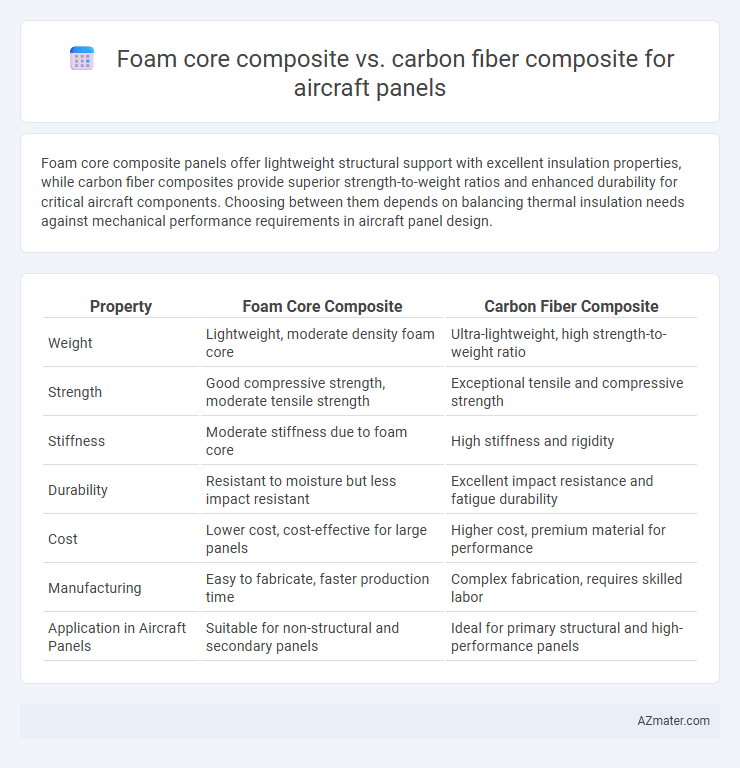Foam core composite panels offer lightweight structural support with excellent insulation properties, while carbon fiber composites provide superior strength-to-weight ratios and enhanced durability for critical aircraft components. Choosing between them depends on balancing thermal insulation needs against mechanical performance requirements in aircraft panel design.
Table of Comparison
| Property | Foam Core Composite | Carbon Fiber Composite |
|---|---|---|
| Weight | Lightweight, moderate density foam core | Ultra-lightweight, high strength-to-weight ratio |
| Strength | Good compressive strength, moderate tensile strength | Exceptional tensile and compressive strength |
| Stiffness | Moderate stiffness due to foam core | High stiffness and rigidity |
| Durability | Resistant to moisture but less impact resistant | Excellent impact resistance and fatigue durability |
| Cost | Lower cost, cost-effective for large panels | Higher cost, premium material for performance |
| Manufacturing | Easy to fabricate, faster production time | Complex fabrication, requires skilled labor |
| Application in Aircraft Panels | Suitable for non-structural and secondary panels | Ideal for primary structural and high-performance panels |
Introduction to Aircraft Panel Materials
Foam core composites offer lightweight structural support with high stiffness-to-weight ratios by combining a foam core with composite face sheets, making them suitable for non-critical aircraft panels. Carbon fiber composites provide superior strength, durability, and fatigue resistance, enabling their use in load-bearing and high-performance aircraft panel applications. Selection between foam core and carbon fiber composites depends on factors such as weight, mechanical properties, cost, and specific aircraft design requirements.
Overview of Foam Core Composite Panels
Foam core composite panels consist of a lightweight foam core sandwiched between two composite face sheets, offering excellent stiffness-to-weight ratio and thermal insulation properties ideal for aircraft interior and non-structural panels. These panels provide good impact resistance and ease of fabrication, making them cost-effective compared to carbon fiber composites, which excel in high-strength structural applications. Foam core composites are widely used in aerospace for their balance of weight reduction, durability, and vibration damping in cabin partitions, flooring, and secondary structural components.
Characteristics of Carbon Fiber Composite Panels
Carbon fiber composite panels exhibit exceptional strength-to-weight ratios, making them ideal for aircraft applications where structural integrity and weight reduction are critical. These panels provide superior stiffness, excellent fatigue resistance, and enhanced durability compared to foam core composites, ensuring long-term performance under varying stress conditions. Their high corrosion resistance and thermal stability contribute to improved safety and lifespan in aerospace environments.
Weight Comparison: Foam Core vs Carbon Fiber
Foam core composites offer significantly lower density compared to carbon fiber composites, resulting in reduced overall weight for aircraft panels, which enhances fuel efficiency and payload capacity. Carbon fiber composites provide higher strength-to-weight ratios but are denser than foam core materials, leading to a heavier panel relative to equivalent foam core structures. The choice between foam core and carbon fiber composites for aircraft panels hinges on balancing weight savings with mechanical performance requirements for specific aerospace applications.
Structural Strength and Stiffness
Foam core composites offer lightweight sandwich structures with moderate stiffness and impact resistance, making them suitable for less critical aircraft panels requiring weight reduction. Carbon fiber composites provide superior structural strength and high stiffness-to-weight ratios, essential for load-bearing panels subjected to significant aerodynamic stresses. The choice depends on balancing weight savings with performance demands, where carbon fiber excels in high-strength, high-stiffness applications.
Durability and Environmental Resistance
Foam core composites offer lightweight structural benefits and moderate durability but lack the high impact resistance and fatigue endurance characteristic of carbon fiber composites. Carbon fiber composites exhibit superior environmental resistance, with excellent tolerance to moisture, temperature fluctuations, and UV exposure, making them ideal for harsh aerospace conditions. While foam core composites may degrade faster under prolonged environmental stress, carbon fiber panels maintain structural integrity and durability over extended service life in aircraft applications.
Cost Analysis: Foam Core vs Carbon Fiber
Foam core composites offer a significant cost advantage over carbon fiber composites in aircraft panel manufacturing due to lower raw material prices and reduced production complexity. While carbon fiber composites provide superior strength-to-weight ratios and durability, their high material and fabrication costs often lead to increased overall expenses. For budget-conscious aerospace applications, foam core panels are often preferred to balance cost efficiency and performance requirements.
Manufacturing Processes and Complexity
Foam core composite aircraft panels involve a sandwich structure with a lightweight foam core bonded between composite skins, utilizing simpler layup and curing techniques that reduce manufacturing complexity and cost. Carbon fiber composite panels require precise fiber orientation and resin infusion or pre-preg layup, followed by autoclave curing, which demands advanced equipment and skilled labor, increasing complexity and production time. The foam core process offers faster assembly with lower tool investment, while carbon fiber composites provide superior strength-to-weight ratio at the expense of more intricate manufacturing steps.
Application Suitability in Aircraft Design
Foam core composites offer excellent lightweight insulation and impact resistance, making them ideal for aircraft interior panels and structural sandwich constructions where weight reduction and thermal performance are crucial. Carbon fiber composites provide superior strength-to-weight ratio and stiffness, suitable for primary structural components and exterior panels subjected to high aerodynamic loads. Selecting between foam core and carbon fiber composites depends on balancing load-bearing requirements with weight efficiency and thermal insulation needs in aircraft design.
Future Trends in Aircraft Panel Composites
Future trends in aircraft panel composites emphasize the development of advanced foam core composites with enhanced thermal insulation and impact resistance, offering weight reduction without compromising structural integrity. Innovations in carbon fiber composite technology focus on improving fiber alignment and resin systems to achieve superior strength-to-weight ratios and durability under extreme operating conditions. Hybrid composites combining foam core and carbon fiber layers are emerging, aiming to optimize mechanical performance and cost-efficiency in next-generation aircraft panel designs.

Infographic: Foam core composite vs Carbon fiber composite for Aircraft panel
 azmater.com
azmater.com